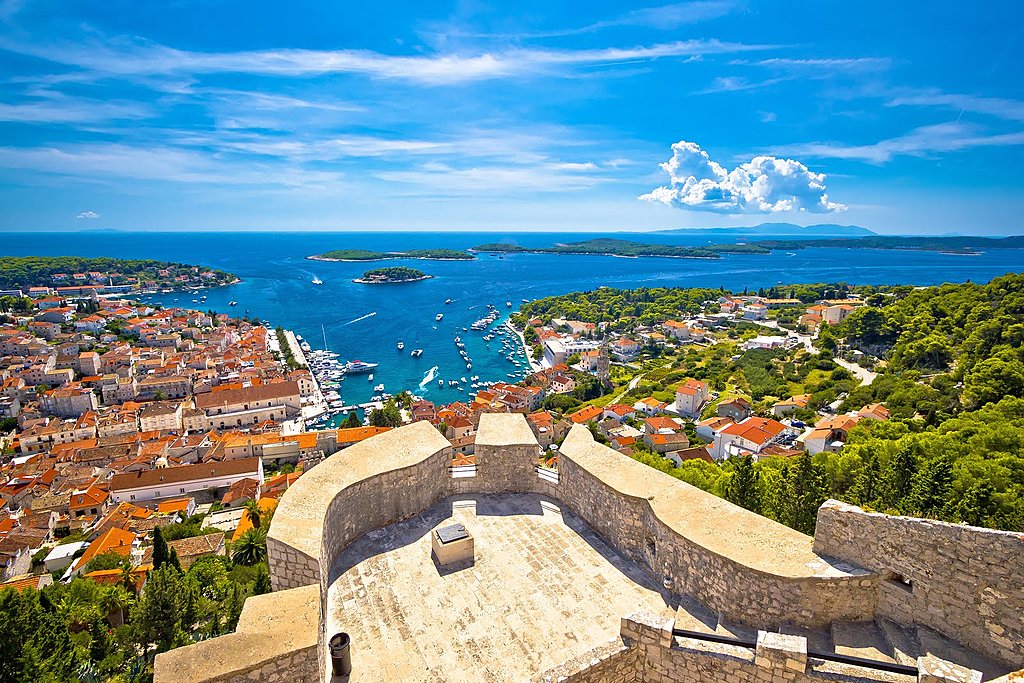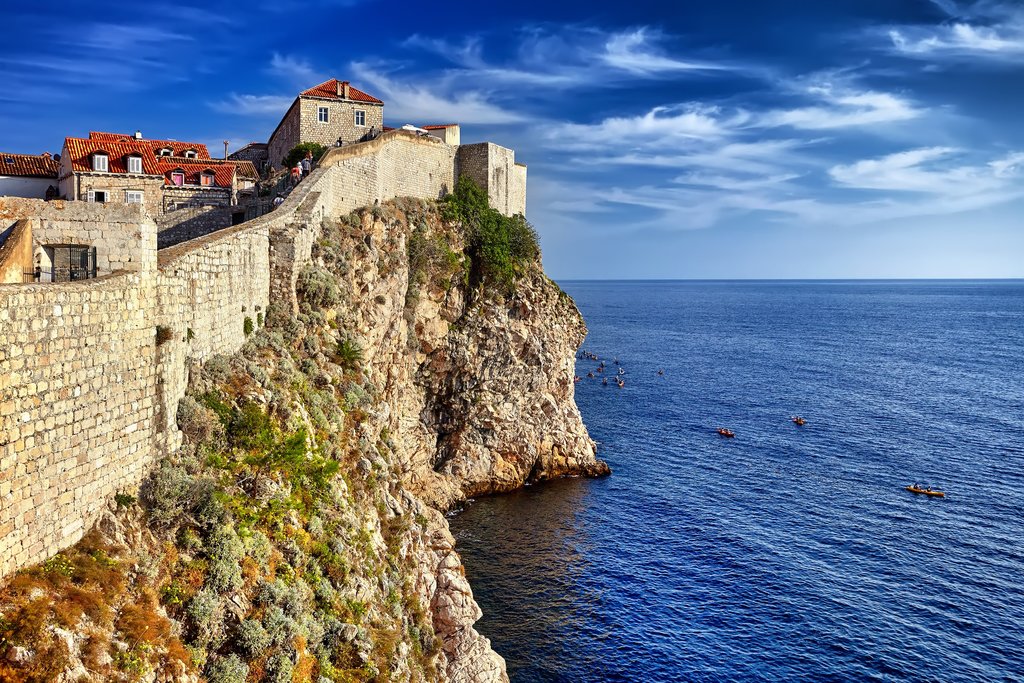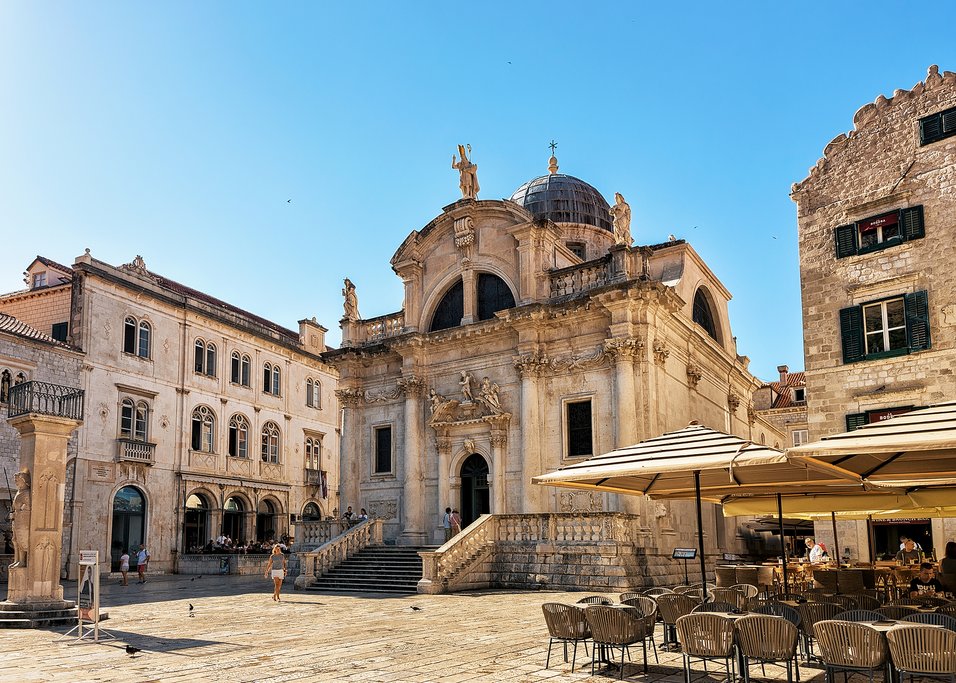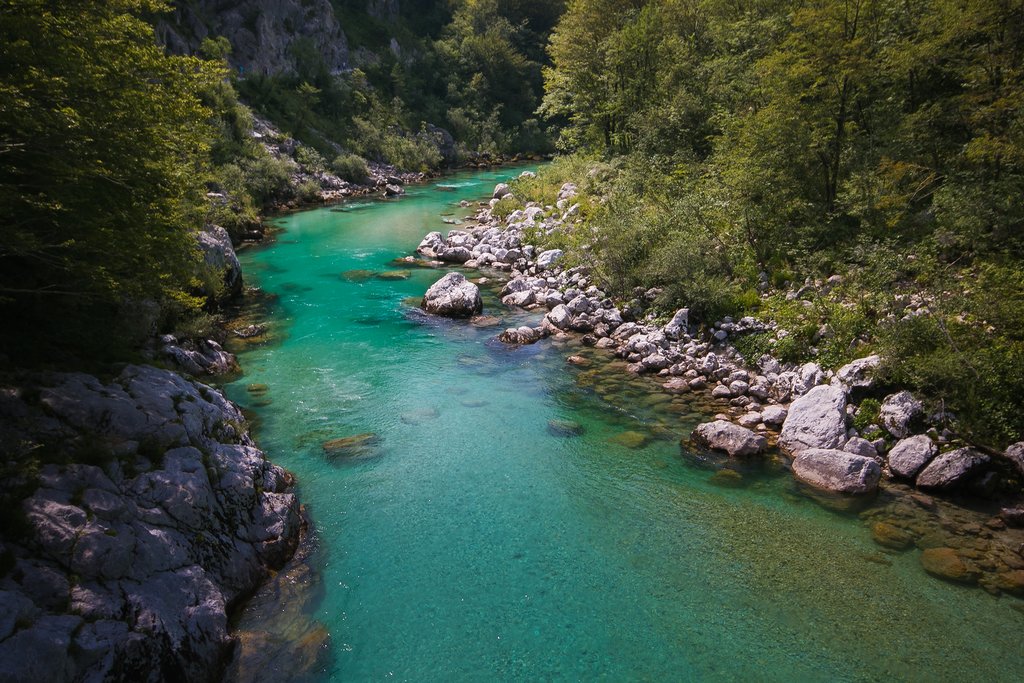Highlights
- Take in the stunning scenery of the Julian Alps as you drive through the Vršič Pass
- Go underground through the stunning canyons of the limestone Škocjan Caves
- Navigate the narrow maze of cobblestoned streets in Rovinj
- Discover dramatic waterfalls and glittering emerald-green lakes in Plitvice Lakes
- Explore the 16th-century stone walls of Dubrovnik's Lovrijenac and Revelin fortresses
Brief Itinerary
| Day | Highlights | Overnight |
|---|---|---|
| Day 1 | Welcome to Zagreb! | Zagreb |
| Day 2 | Scenic Castles of the Zagorje Region | Zagreb |
| Day 3 | Zagreb to Ljubljana | Ljubljana |
| Day 4 | Ljubljana to Lake Bled | Lake Bled |
| Day 5 | Lake Bohinj (Day Trip from Lake Bled) | Lake Bled |
| Day 6 | Lake Bled to Kobarid | Kobarid |
| Day 7 | Kobarid to Rovinj, Stopping at Škocjan Caves | Rovinj |
| Day 8 | Into the Heart of Istria: Grožnjan, Oprtalj, & Motovun | Rovinj |
| Day 9 | Rovinj to Plitvice Lakes National Park via Opatija | Plitvice Lakes |
| Day 10 | Sunrise at Plitvice Lakes, Drive to Split | Split |
| Day 11 | Ferry from Split to Hvar | Hvar Town |
| Day 12 | Explore Hvar | Hvar Town |
| Day 13 | Hvar Offroad Tour | Hvar Town |
| Day 14 | Ferry from Hvar to Dubrovnik | Dubrovnik |
| Day 15 | Walking Tour of Dubrovnik | Dubrovnik |
| Day 16 | Depart Dubrovnik |
Detailed Itinerary
Day 1: Welcome to Zagreb!

Start your adventure from Zagreb, the capital of Croatia. Upon arrival at the airport, you'll be transferred to your hotel to settle in. The rest of the day is yours to spend as you like. The city center is easily walkable and the streets and parks are easy to navigate by foot. All the main attractions and restaurants are within walking distance.
A gem of a European city, Zagreb is at once historic and new. It's filled with leafy green parks and gothic/neo-renaissance buildings, yet there's also modern shopping complexes, outdoor malls, and endless dining and drinking options. Consider heading out on a guided walking tour of the historic heart of the city. This involves walking from Ban Jelačić, the main square, to Zagreb's Upper Town and passing through local markets before reaching St. Mark's Square.
Alternatively, you can visit one of the many museums and art galleries, like the Homeland War Museum, the Nikola Tesla Technical Museum, or the ever-popular Museum of Broken Hearts. Or stroll through the city center, enjoying 17th-century neo-baroque architecture found at Zagreb's Art Pavilion and Croatian National Theater.
Zagreb also has a number of beautiful city parks which are great for exploring and people watching, especially in the late afternoon. Maksimir is a great option, with a variety of cafés nearby to pick up a coffee for your stroll.
Day 2: Scenic Castles of the Zagorje Region

Just a few miles northwest of Zagreb lies Zagorje, a bucolic hilly region, dotted with Renaissance and medieval fortresses, numerous baroque castles, and family-run vineyards and farms. It's a memorable, romantic landscape that will take you back in time to a sense of both the aristocratic past and the rural traditional way of life that still exists in Croatia today. A quick day trip from Zagreb allows you to immerse yourself in this beautiful region.
Find your way to Trakošćan Castle, a good example of one of these storybook locales, as it sits perched on a hill adjacent to a glassy lake. The castle, a historic landmark, was built in the 14th century as a defensive fortress but was later used as a home for aristocratic Croatian families. On a tour, you can not only visit the castle grounds but you'll go inside and explore all four floors, which function as a museum with permanent exhibitions.
Afterward, visit Veliki Tabor Castle, which is located just southwest of Trakošćan. This gothic-renaissance castle dates to the 16th century and also sits on a green hill overlooking the fertile countryside. It was originally built for a noble Hungarian family and its fortifications were designed to defend against Turkish invaders. A tour of Veliki includes visits to the towers, guardhouses, and inner courtyard plus a small museum featuring exhibitions of medieval artifacts like armor, weapons, and paintings.
Apart from castles, explore nearby old villages, like Kumrovec, where you'll find restored peasants' houses from the 19th century. These are great areas to browse local craft shops and enjoy some traditional country cuisine like grilled lamb, meat skewers, and veal stuffed with cheese and ham. Kumrovec is most well known for being the birthplace of Marshal Josip Broz Tito, the communist revolutionary who was President of Yugoslavia from 1953 to 1980.
Day 3: Zagreb to Ljubljana

This morning you will drive two hours west to charming Ljubljana. Check into your hotel before taking the rest of the day to explore Slovenia's lively capital.
Saunter down the main street along the banks of the Ljubljanica River, stopping in whatever small boutique, outdoor café, or wine bar terrace strikes your fancy as you breathe in the fresh air of one of the continent's greenest cities. A classic European castle, parks, and churches are all on offer as you wind your way around town by foot or bicycle.
You'll notice the legacy of modern architect Jože Plečnik around the city at worthwhile stops such as the National Library, Central Market, Triple Bridge, and Plečnik's own home-turned-museum, all under the watchful eyes of the city's many signature dragons. The Central Market is also a key site for sampling local cuisine at its many stalls.
Driving time (Zagreb to Ljubljana): 2 hours
Day 4: Ljubljana to Lake Bled

Transfer from Ljubljana to the fairytale shores of Lake Bled. Surrounded by the soaring peaks of the Julian Alps, Bled draws honeymooners and adventure-seekers alike.
You can also climb up to the castle and tour its smithy, wine cellar, and printing press before enjoying a traditional meal in the restaurant, or row or paddleboard across the placid waters. Once you reach the fairytale island at the lake's center, climb up the church's 99 steps, where legend has it the ringing of the bell can grant your wishes. If that's still not enough, enjoy cycling on side roads through typical Slovenian countryside, or simply sunbathe on the lakeside with a slice of the famous Bled cream cake at the Park Hotel or Slascicarna Zima bakery.
Driving time (Ljubljana to Lake Bled): 1 hour
Day 5: Lake Bohinj (Day Trip from Lake Bled)

Nearby Lake Bohinj deserves time for exploration of its own, giving its neighboring lake some serious competition for the prettiest waterfront views. There are countless walks in the area for all ability levels; you choose the one that suits you best, or go vertical with rock climbing instead. Don't forget to pay a visit to the statue of the Zlatorog, or Golden Horn, a mythical stag believed to live in the mountains.
If you're feeling more aquatically inclined, you can also canoe, kayak, or stand-up paddleboard on the smooth water before your return to Lake Bled. If you haven't visited Bled Castle yet, consider splurging on a royal dinner with a view at its restaurant.
Driving time (Lake Bled to Lake Bohinj): 30 minutes
Day 6: Lake Bled to Kobarid

Get back on the road this morning to make your way to the quaint town of Kobarid. Surrounded by mountain peaks, Kobarid feels more Mediterranean than Alpine where little has changed since Ernest Hemingway's description of then Caporetto in 'A Farewell to Arms.'
From Lake Bled you'll follow a route that curves around Triglav National Park through the mountain town of Kranjska Gora and then across Slovenia's highest pass, the Vršič Pass (5,285 feet / 1,611 m) in the central Julian Alps. Admire the nearby limestone walls as you make your way up the winding road with potential detours to several view-filled walks of varying lengths, including a stroll into the region's history on paths built by Russian prisoners of war.
After you've stretched your legs, have a coffee with a scenic mountain view and a typical alpine lunch in a cozy hut. In the afternoon, drive to the Soča Valley to explore its hidden spots, including WWI forts, waterfalls, and river gorges. Carry on south toward the town of Bovec, a little way north of Kobarid. As this region was the scene of the largest mountain battle in World War I, history buffs will find a dedicated museum in Kobarid as well as several memorials to fallen soldiers in the area. Kobarid is also home to some of the country's best restaurants. One great option to try is Hiša Franko.
Driving time (Lake Bled to Kobarid): 2-2.5 hours
Chat with a local specialist who can help organize your trip.
Day 7: Kobarid to Rovinj, Stopping at Škocjan Caves

Get an early start this morning to make your way into Slovenia's Karst region, beginning with a visit to Škocjan Caves. A UNESCO World Heritage Site, you can go underground and take a walk along the boardwalks that lead you through the specialized ecosystem of one of the world's largest known subterranean caverns. If there are time and interest, why not stop to ride an electric train through 15 miles (24 km) of the nearby Postojna cave system as you make your way into Croatia, along the Adriatic coast and onward to Rovinj.
Upon your arrival in Rovinj, you'll settle into your accommodation before taking the rest of the afternoon and evening to explore this small jewel on the west coast of the romantic Istrian Peninsula.
Though Rovinj remains an active fishing port today, it wasn't until 1763 that it became part of the mainland. As such, its restricted access resulted in the labyrinth of narrow, cobblestoned streets you see today. Explore Old Town and marvel at the centuries-old Venetian influenced architecture as you pass under archways, through alleyways, and up stone stairwells. Navigate your way to Balbi's Arch and the 12th-century Town Clock, noting Rovinj's skyline dominated by the baroque St. Euphemia Church.
Seek out your choice of interest from churches to galleries and pebbled beaches, capping off the day with a delicious dinner of fresh fish and local wines, like Teran and Malvasia.
Driving time (Kobarid to Škocjan): 2 hours
Driving time (Škocjan to Rovinj): 2 hours
Day 8: Into the Heart of Istria: Grožnjan, Oprtalj, & Motovun

Today, head inland to explore the rolling hills of Istria, taste a few of the best local olive oil and wine varieties and explore some of the most charming villages in the country.
First, drive north to Grožnjan, a medieval hilltop town surrounded by terraced olive groves and vineyards. Once an important stronghold for the Venetians, the town's importance went into decline with the collapse of their empire (in the 18th-century). It wasn't until the sixties Grožnjan became what it is today: the town of artists. Lose yourself in the maze of narrow and cobblestoned streets, stopping to pop into one of the numerous art studios and galleries.
Then, continue on to Oprtalj, a medieval fort town sitting on the northern side of the Mirna river valley. Oprtalj is home to traditional narrow streets, shops, and fine examples of Istrian and Venetian architecture, including the 16th-century St. George's Church and Venetian style bell tower.
Finally, drive south to explore Motovun, an ancient sleepy town located atop a 909-foot (277 m) hill. Its present appearance, with the city walls surrounding the center of the town, dates back to the Middle Ages. Sitting opposite Oprtalj on the southern side of the Mirna river, Motovun today hosts a popular film festival for one week in the summer. Sample local wines and enjoy a meal with truffles sourced from the nearby truffle-rich forests.
Driving time (Rovinj to Grožnjan): 1.25 hours
Driving time (Grožnjan to Oprtalj): 30 minutes
Driving time (Oprtalj to Rovinj): 1.25 hours
Day 9: Rovinj to Plitvice Lakes National Park via Opatija

This morning you'll make the drive to Opatija before carrying on to Plitvice Lakes National Park, one of Croatia's most popular national parks.
Head northeast across the Istrian Peninsula and stop in the coastal town of Opatija. A popular tourist destination since the 19th century, Opatija is known for its Mediterranean climate and historic Habsburg-era buildings, remnants of its touristic past. Stroll along the famous Lungomare, a promenade that follows the Adriatic coastline and enjoy a drink at one of the many bars that overlook the Kvarner Gulf.
Continue east to Plitvice Lakes National Park, arriving in the afternoon to settle into your accommodation and to explore the park at your leisure. A must-visit for any traveler to Croatia, the UNESCO-protected park is comprised of an exquisite collection of 16 glassy emerald green and blue travertine lakes, more than 90 cascading waterfalls that seemingly cover every corner of the park, and numerous caves. The terraced lakes are surrounded by beech and pine forests and are home to extensive wildlife.
Here, you can request a private, expert local guide to lead you throughout the park along the wooden paths and bridges to show you the most impressive points of interest and explain the significance of its history and natural features. After your tour, you will have free time to continue exploring, have dinner, or you may wish to bring a bought dinner (and a bottle of wine!) with you to enjoy a picnic.
Driving time (Rovinj to Opatija): 1.5 hours
Driving time (Opatija to Plitvice): 2.5 hours
Day 10: Sunrise at Plitvice Lakes, Drive to Split

Early morning is one of the best times to visit Plitvice Lakes before the mid-day crowds arrive. You can explore the park on your own or opt for a local guide who will take you on a number of defined routes of varying lengths throughout the park. After enjoying a leisurely morning in Plitvice, carry on your way south to Split. Upon arriving in Split, check into your hotel and settle in before taking the rest of the afternoon to wander Split's historic center.
Start at Pjaca Square for pretty views of white marble tiles, the Iron Gate (the western entrance to Diocletian's Palace), a Romanesque clock tower with the remains of a medieval sundial, and the 15th-century Town Hall. Stop for lunch at Trattoria Bajamont, just north of the Iron Gate. From there, visit the popular Voćni trg or Fruit Square. Here you can enjoy renaissance architecture, influenced during Split's Venetian era. For a bit of shopping and a bite to eat head to Marmont Street, though you'll want to make your way to the waterfront to catch the sunset.
In the evening, take a stroll along Split's seafront Riva to admire the views over the Adriatic before finding the off-beat Konoba Dioklecijan restaurant, just to the left of the Bronze Gate for dinner, its outdoor terrace built into the walls of famed Diocletian's Palace.
Driving time (Plitvice to Split): 2-3 hours
Day 11: Ferry from Split to Hvar

After an easy morning in Split, catch the ferry to the island of Hvar and check into your hotel. A Croatian island in the Adriatic Sea, Hvar is a popular destination with tourists due to its natural setting, mild climate, and its historic port town of the same name. Highlights of Hvar Town include its 13th-century walls, a hilltop fortress, and the main square anchored by the Renaissance-era Cathedral.
For some of the best views of the island, Hvar Town, and the nearby Pakleni Islands take a short walk up to the 16th-century Španjola Fortress. Or, join a kayaking tour and head out on the Adriatic to discover the many secluded coves that outline the islands. To cover some ground and appreciate the variation in island landscape: from lavender plantations and olive groves to vineyards and pine woods, you may like to join a (wine tasting) cycling or hiking tour. The less active might opt to rent a scooter for faster coverage of the local scenery.
After the day's adventures, treat yourself to a drink in the ancient piazza of Hvar overlooking the Venetian loggia, 7th-century fortification walls, and the oldest municipal theater in Europe.
Ferry time: 1.5-2 hours
Day 12: Explore Hvar

Today, you have free range to explore Hvar at your own pace. A great way to discover much of the island is to rent a scooter in Hvar Town and drive along the coastline through olive groves, lavender fields, and vineyards, stopping along the way to lie out on a beach you happen upon. In the afternoon, switch gears and join a half-day wine tour to sample some of the region's best wines as well as learn about its 2,400-year-old history. In the early evening, bring a bottle of wine and head to Tito's Caves, just north of Stari Grad, for a picnic as you watch the sun set from these hidden-away caves.
The more athletically inclined might prefer an early morning start to trek up to the 16th-century Španjola Fortress for views over Hvar Town and the Pakleni Islands, followed by a cycling tour around Hvar to explore the inner part of the island. Alternatively, another great option is to embark on a hike from Hvar Town to visit Velo Grablje, a near-deserted 500-year-old town, and Malo Grablje a nice hike that takes you down a canyon into the village. Here you can stop for lunch to enjoy a delicious meal at perhaps the most authentic of the island's taverns.
One last option is to explore the nearby Pakleni Islands. You can rent a private taxi boat to tour around the islands for the day, where you might consider taking a 15-minute water taxi to Jerolim and Stipnska, or continue on to other islands further out to walk around and explore. For the more adventurous, there is the option to go on a guided full-day or half-day sailing or kayaking tour of the islands—a great way to discover the many secluded beaches and lagoons!
Day 13: Hvar Offroad Tour

Enjoy a full day of guided offroading fun as you cover the undulating island terrain, accented with vineyard-covered hills, thick olive groves, and fragrant fields full of rosemary and lavender. Set out from Hvar Town along a dirt road to the abandoned 16th-century village of Malo Grablje before carrying on to the slightly older, UNESCO-protected Velo Grablje. Once home to a thriving lavender industry, Velo Grablje is slowly undergoing a revival. Today, only a few people inhabit the village throughout the year, but many gather for the annual lavender festival.
Stop for an authentic lunch at a family-run tavern where your meal is traditionally prepared using locally sourced ingredients and the peka, a bell-shaped lid that is covered in coal. Next, you'll spend a little time relaxing on Soline beach on the northern coast of the island near Vrboska before it's time to head up Vidikovac for views over the Stari Grad Plain, an agricultural landscape that was first colonized by the Greeks and is still maintained today, as well as Stari Grad itself, Croatia's oldest township.
After a moment to absorb the breathtaking surroundings, you'll ascend Hvar's tallest peak, St. Nicholas for additional sweeping vistas over the Adriatic and neighboring islands like Brač, Korčula, and Vis and possibly even the east coast of Italy! On your way down the sloping hillside lies Sveta Nedija, a village surrounded by vineyards so steep they’re renowned the world over for being extraordinarily difficult to tend; but they're also known for the high-quality red wine they produce from the Dalmatian plavac grape. Continue along the southern edge of Hvar as you make your way back to your accommodation.
Day 14: Ferry from Hvar to Dubrovnik

Catch a morning ferry today to Dubrovnik where you will have the day to explore one of the most ancient fortress cities in Europe. Known as the "Pearl of the Adriatic", Dubrovnik is a piece of history. While there's evidence of settlements as far back as the Byzantine era, this area only came into its own in the 12th and 13th centuries when it was under the rule of the Venetians. Throughout the middle ages, it was a fortress port encircled by stone walls and filled with baroque churches and renaissance/gothic palaces that still stand today.
After checking into your hotel, you'll want to get out and explore. Can't-miss activities include riding the cable car up to Srđ Mountain to take in the sunset over the nearby Elafiti Islands, visiting Lovrijenac and Bokar fortresses, and walking along the smooth, limestone-paved streets of historic Old Town. And be sure to find your way to Stradun, Dubrovnik's main street to get your bearings and to choose from a number of excellent restaurants and wine bars. Alternatively, there's Buza Bar along the water's edge and outside the city walls—a great spot to enjoy a cocktail while taking in the sunset.
Ferry time (Hvar to Dubrovnik): 3.5 hours
Day 15: Walking Tour of Dubrovnik

Start your day early (around 8 am) to avoid the crowds and to embark on a tour of Dubrovnik where you'll meet your expert guide outside the entrance to the medieval city at the 16th-century Pile Gate. Entering Old Town, you'll uncover centuries of the city's rich history as you listen to stories of local life and legends and of the importance Dubrovnik once held in the era of the Republic. Highlights include Onofrio's Fountain, the 15th century Rector's Palace, Luza Square, the Church of St. Blaise (St. Vlaho), and the café-lined streets of Brsalje Street.
After touring the streets and alleys, you'll head for Lovrijenac Fortress as well as the city's impressive defensive walls, the second-largest set of city walls in the world. At certain places the wall rises 75 feet high, offering excellent vantage points for photos of the coastline.
For the rest of the afternoon, explore Dubrovnik and its surroundings on your own or enjoy the afternoon sun on the nearby beaches. Come early evening, you can get stunning panoramic views over the city and Adriatic by taking the cable car up to Srđ Mountain before descending back down for dinner at one of Dubrovnik's great restaurants.
Day 16: Depart Dubrovnik

Depending on when you depart, you may have time to visit one of Dubrovnik's museums, like the Franciscan Monastery and Museum. This large complex houses many treasures, including the world's third oldest pharmacy dating from 1317.
Alternatively, for a collection of 15,000 pieces of interesting works, visit the Rector's Palace and Cultural Historical Museum. Wander this well-preserved palace-turned-museum and explore its exhibits, some detailing life in the Republic of Ragusa during medieval times.
The drive to the airport from Dubrovnik takes around 45 minutes with normal traffic.
